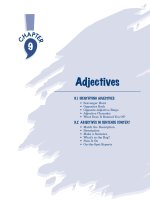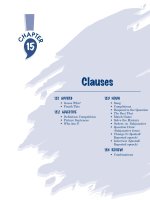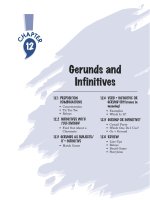fun With Grammar - Verbs - review
Bạn đang xem bản rút gọn của tài liệu. Xem và tải ngay bản đầy đủ của tài liệu tại đây (259.62 KB, 16 trang )
Verbs: Review
4
4.1 REVIEW OF PERFECT TENSES
• Time Line
4.2 REVIEW OF ALL VERBS FORMS
• Song
• Error Analysis Draw
• Board Game
• Mixed-up Answers
• Short Answers
• Time Chart
• Dice Shoot
• Error Analysis
89
4.1 REVIEW OF PERFECT TENSES
1. TIME LINE
Materials:
Board
Dynamic:
Whole class
Time:
15 minutes
Procedure:
1. Draw a time line on the board.
2. Ask for a student volunteer to provide dates and facts about past
events in his/her life. Write them on the time line.
3. Ask the class to predict what this student will do in the future.
Write the suggestions on the time line.
Example:
1995 1996 1997 1998 1999
• ••• •
finish hs come to U.S. now return home get married
4. With the help of the class, write two sentences based on the time
line for each of the perfect tenses.
Examples:
a. Before John came to the United States, he had finished high
school.
b. He has been studying English since he came to the United
States.
c. He will have returned home by the time he gets married.
5. For homework, have the students make their own time line and
write two sentences for each of the perfect tenses based on their
time line.
SUGGESTION: Cash register tapes are inexpensive and make good
time lines. Instead of doing a volunteer time line on the board, you
can divide the class into groups and have each group construct a
time line for one of its members. Then put the tapes on the walls
and have another group make sentences using some other group’s
time line.
4.2 REVIEW OF ALL VERB FORMS
1. SONG
Materials:
Worksheet of lyrics based on models in
Chapter 3
Tape and tape player (optional)
Dynamic:
Pairs
Time:
20 minutes
Procedure:
1. Prepare a handout for each student of song lyrics with verbs
omitted (make sure to omit only verbs whose tenses/forms the
students can figure out from context). Sometimes many different
forms can work in the song.
2. Divide the class into pairs, and have each pair work on the song to
fill in the missing verb forms.
3. Go over the answers together, or listen to a tape of the song to
check answers. Be sure to explain where more than one answer is
possible even if it is not the one in the song.
NOTE: Choose a song that has verb forms appropriate to your level.
If you find a song that is appropriate for reviewing forms that you
have covered but has one or two forms you have not studied, simply
leave those in the song. Some good songs for this activity are “Rocky
Raccoon” (Lennon and McCartney, sung by the Beatles) and “It
Doesn’t Matter Anymore” (Paul Anka).
2. ERROR ANALYSIS DRAW
Materials:
Worksheet 28A or 28B, cut into strips,
or make your own
Dynamic:
Teams
Time:
25 minutes
Procedure: 1. Divide the class into two teams. Have them stand or sit on
opposite sides of the room. If your class is large, you can divide
the class into several teams.
2. A student from the first team comes to the front of the class and
selects a strip. He or she reads the strip aloud and decides if the
sentence is correct or incorrect. If it is incorrect, the student must
correct it.
90
91
NOTE: It is probably best not to let the team help, but if you are
using small teams or want more interaction, you can have the team
discuss the sentence. For scoring purposes, accept only the answer
given by the student who selected the strip.
3. If the sentence is correct and the student says so, the team
receives a point. If the sentence is incorrect and the student
correctly identifies it as such, the team receives a point. The team
receives one more point for correcting it. If the student identifies a
sentence as incorrect but fails to provide an accurate correction,
the other team (or next team if you have more than two) can
“steal” a point by correcting the sentence. That team then takes
the next turn.
SUGGESTION: Make your own strips so that the grammar covered
accurately reflects the content of your course. Use the worksheet as a
model only if it is appropriate for your class. Cash register tapes
work well for make-your-own strips because they can be seen by
everyone. They can be purchased at office supply stores or large
variety stores.
3. BOARD GAME
Materials:
Worksheet 29A (lower level) or
29B (higher levels)
Die for each team, one marker
for each student
Dynamic:
Groups
Time:
20 minutes
Procedure:
1. Divide the class into teams of approximately four. Distribute a
copy of the worksheet to each team.
2. Students roll to see who goes first. The students move their
markers around the game board. When a player lands on a square
with a sentence, he/she must correct the sentence. If the group
judges the corrected answer to be accurate, the student may roll
again. If not, the turn passes to the next student. The players
should not discuss the correct answer when an incorrect answer
has been given since another player may land on that same space
and have a chance to give an answer.
3. Circulate among the groups to see how they are doing and to act
as judge if the group cannot decide if an answer is correct. The
first player in each group to reach the end is the winner.
4. MIXED-UP ANSWERS
Materials:
Board
Dynamic:
Teams
Time:
10 minutes
Procedure:
1. Divide the class into two teams and have them line up on either
side of the board.
2. On each side of the board write the same short answers, but in
mixed-up order (so that a student on one team cannot simply look
over and see where his/her counterpart is marking).
Sample short answers:
3. The first student from each team comes to the board. Ask a
question. The students try to circle the answer as quickly as
possible. The first student to circle the correct answer gets a point
for his/her team.
Sample questions:
Do you have a sister?
Did you eat lunch today?
Did we have class yesterday?
Are you in level 2?
Is John’s sister married?
Was Tom late for class today?
NOTE: The questions can be about your class or not. The students do
not need to know if the answer is yes or no. They are looking for the
correct verb form that answers the question. It is recommended that
you do not have both yes and no answers (for example: “Yes, I do”
and “No, I don’t”) that could be appropriate to a question. There
should only be one possible answer for each question asked.
Variation:
Use tag board sentence strips attached to the board. Students check
next to the strip; their marks can be erased without erasing the
sentence, and you can reuse the strips in other classes.
Yes, I do.
No, he wasn’t.
No, we didn’t.
Yes, she is.
Yes, I am.
No, I didn’t.
Yes, I am.
No, I didn't.
Yes, I do.
Yes, she is.
No, we didn't.
No, he wasn't.
92
93
5. SHORT ANSWERS
Materials:
Worksheet 30
Dynamic:
Small groups
Time:
20 minutes
Procedure:
1. Divide the class into groups of three or four.
2. Give each group approximately 5 cards with short answers on
them. Have the group work together to create appropriate
questions for the answers.
Example:
Sample card: Yes I did.
Student question: Did you eat breakfast this morning?
3. Have each group read aloud its questions and answers and have
the other groups decide if they are good matches. Another way to
go over the questions is to have each group read the questions
they have created and have the other students provide the short
answers. If the question matches the answer given to the group on
the card, the group has done a good job of creating a question.
(Either a yes or a no answer is acceptable.)
6. TIME CHART
Materials:
Worksheet 31
Dynamic:
Pairs
Time:
15 minutes
Procedure:
1. Divide the class into pairs. Give each pair a copy of the worksheet.
The students make sentences as directed, using the information in
the chart.
2. When all pairs are finished, call some students to the board to
write their sentences. The class decides whether they are correct.
If not, correct the sentences.









